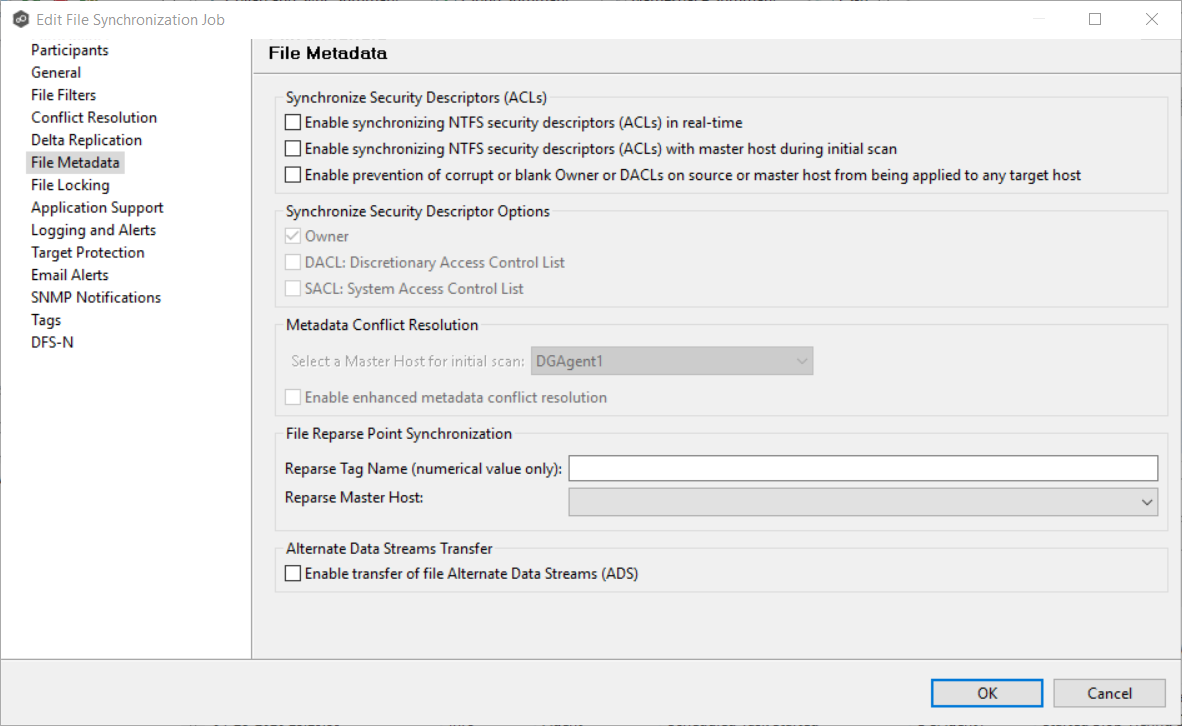The File Metadata page in the Edit File Synchronization Job dialog allows you to modify your file metadata synchronization settings and provides some additional options not available when creating the job. See File Metadata Synchronization in Advanced Topics for more information about file metadata replication.
To enable file metadata synchronization:
1.Select when you want the metadata synchronized (you can select one or both options):
•Enable synchronizing NTFS security descriptors (ACLs) in real-time - Select this option if you want the metadata replicated in real-time. If enabled, changes to the selected security descriptor components (Owner, DACL, and SACL) will be transferred to the target host file(s) as they occur.
•Enable synchronizing NTFS security descriptors (ACLs) with master host during initial scan - Select this option if you want the metadata replicated during the initial scan. If enabled, changes to the selected security descriptor components (Owner, DACL, and SACL) will be synchronized during the initial scan.

2.Click OK in the message that appears after selecting a metadata option.
3.If you selected either of the first two options in the Synchronize Security Descriptor Options section, select the security descriptor components (Owner, DACL, and SACL) to be synchronized.
Note: To synchronize SACLs or Owner, the user that a Peer Agent service is run under on each participating host must have permission to read and write Owner and SACLs.
4.If you selected the option for metadata synchronization during the initial scan, select the host to be used as the master host in case of file metadata conflict.
If a master host is not selected, then no metadata synchronization will be performed during the initial scan. If one or more security descriptors do not match across participants during the initial scan, conflict resolution will use permissions from the designated master host as the winner. If the file does not exist on the designated master host, a winner will be randomly picked from the other participants.
5.(Optional) Click the Enable enhanced metadata conflict resolution checkbox.
If enabled, this option ensures that when a metadata conflict occurs and a file or folder is written to a target, the Peer Agent service account is not assigned as the owner of that file or folder. If the Peer Agent service account is the owner, the user may not have permission to access the file or folder.
Note: The Peer Agent service account cannot be a local or system administrator. As described in Peer Global File Service - Environmental Requirements, the Peer agent service account should be an actual user.
6.(Optional) Enter values for one or both file reparse point data synchronization options:
•Reparse Tag Name - Enter a single numerical value. Must be either blank (if blank, reparse synchronization will be disabled) or greater than or equal to 0. The default for Symantec Enterprise Vault is 16. A value of 0 enables reparse point synchronization for all reparse file types. If you are unsure as to what value to use, then contact Peer Software technical support, or you can use a value of 0 if you are sure that you are only utilizing one vendor's reparse point functionality.
•Reparse Master Host - Select a master host. If a master host is selected, then when the last modified times and file sizes match on all hosts, but the file reparse attribute differs (e.g. archived/offline versus unarchived on file server), then the file reparse data will be synchronized to match the file located on the master host. For Enterprise Vault, this should be the server where you run the archiving task on. If the value is left blank, then no reparse data synchronization will be performed, and the files will be left in their current state.
Note: Use this option only if you are utilizing archiving or hierarchical storage solutions that make use of NTFS file reparse points to access data in a remote location, such as Symantec's Enterprise Vault. Enabling this option allows synchronization of a file's reparse data, and not the actual offline content, to target hosts, and prevents the offline file from being recalled from the remote storage device.
7.(Optional) Select the Enable transfer of file Alternate Data Stream (ADS) checkbox.
If enabled, Alternate Data Streams (ADS) of updated files will be transferred to the corresponding files on target participants as a post process of the normal file synchronization.
Known limitation: ADS information is transferred only when a modification on the actual file itself is detected. ADS will not be compared between participants. The updated file’s ADS will be applied to the corresponding files on target participants.
8.Click OK to close the Edit wizard or select another configuration item to modify.